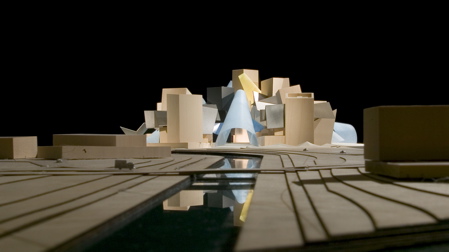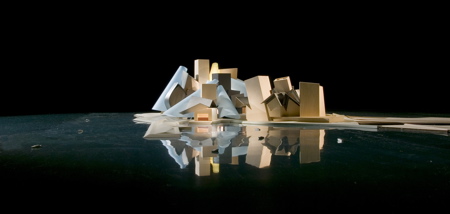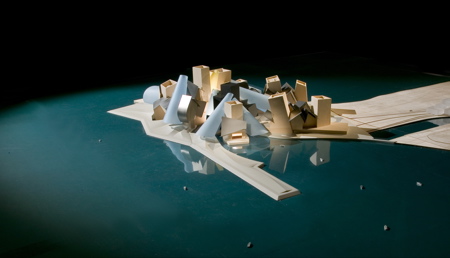The trouble with a tabula rasa is that the tabula is rarely rasa after all.



Adu Dhabi has unveiled it's plans for a cultural district on Saadiyat Island ("Happiness Island"). But by inviting four of the biggest names in world architecture - Hadid, Ando, Gehry and Nouvel to create a performing arts centre, a maritime museum, an art museum and a classical museum respectively on a blank 670 acre canvas masterplanned by SOM, questions inevitably arise as to whose culture will be represented.
In the wonderful book, Delirious New York, Rem Koolhaas memorably describes Le Corbusier as a "Cartesian carpetbagger", attempting to get his Radiant City concept of huge cruciform skyscrapers built, anywhere, after the rejection of his Plan Voisin for Paris.
Frank Gehry is the modern equivalent - a non-cartesian carpetbagger. There is no city in the world that wouldn't be improved by a Gehry Guggenheim, Walt Disney Concert Hall or Experience Music Project. Often called the Bilbao-factor, the vision that is sold to most second-order cities of the world is that if they want to step up a gear, the answer is to bankroll at $400 million curvilnear temple to the arts.
Abu Dhabi is the latest city to fall under the Gehry/Guggenheim spell, and here he's really turned the Gehryfication dial up to 11. To paraphrase Spinal Tap further, the question is how much more Gehry could it be? And the answer is, none more Gehry.
Many artists later works tend towards self-reference, endless repeating the formula that worked, reducing their initial breadth of ideas to one unrelenting central theme, an instantly recognisable motif. Obvious examples would be the paintings of Piet Mondrian or Mark Rothko. But it easy for this self-referential loop to drift into self-parody, such the books of our beloved JG Ballard, whether knowingly or unknowingly.
Has Gehry fallen into the realms of self-parody? Unlike painters, for an architect to relentlessly churn out the same formal tropes regardless of context or site is more disturbing. From the press release, quoted at Dezeen.
"The site itself, virtually on the water or close to the water on all sides, in a desert landscape with the beautiful sea and the light quality of the place suggested some of the direction."
I'm not buying this at all. Is he doomed to reproduce his signature style around the world for clients with deep pockets and cities with aspirations of instant cultural kudos?
The one-style fits anywhere approach to architecture is one that has it's detractors, and the Saadiyat Island development in Adu Dhabi is one that has attracted criticism as a kind of globalisation, or perhaps more accurately a cultural imperialism.
In an deeply suspicious article, A Vision in the Desert, in the New York Times, Nicolai Ourousoff reviews the designs in Adu Dhabi as a new Xanadu in the desert, but there is an unpleasant subtext to the article which attempts to contrast Abu Dhabi's desires for a quick hit of architectural credibility with the urban decay of Beruit and Baghdad:
"With once-proud cities like Beirut and Baghdad ripped apart by political conflict bordering on civil war, Abu Dhabi offers the hope of a major realignment, a chance to plant the seeds for a fertile new cultural model in the Middle East."
This is an abhorrent statement, firstly because it is such a gross simplification and skewed viewpoint of the situations in Baghdad and Beruit, but it casts Adu Dhabi, Baghdad and Beirut as some kind of homogeneous Middle East bloc with no separate identity of their own.
Ouroussoff is rightly called out for this in a discussion at Archinect, in which Javier Arbona writes:
"Ouroussoff is himself putting into practice the very obscurantist colonialism that he dismisses initially as "global branding" and which rewrites its own history. This reeks. But rather than actually succeeding at disabusing the pernicious monumentality of the project that just helps to make more invisible the American violence in the region, Ouroussoff only reveals himself as a pawn to the disappearing act".
Who is the cultural quarter in Abu Dhabi being built for? My guess is that it is more about Adu Dhabi's desire to tap into the Bilbao factor, to increase it's standing in the world, to attract tourists and overseas investment; and to compete with the folks down the road in Dubai, rather than the cultural enrichment of the citizens of the Emirates themselves.
The Emirates are defining their own identity precisely by doing the opposite - an ahistorical non-identity, a brave new world of shining global modernity.
Previously:
